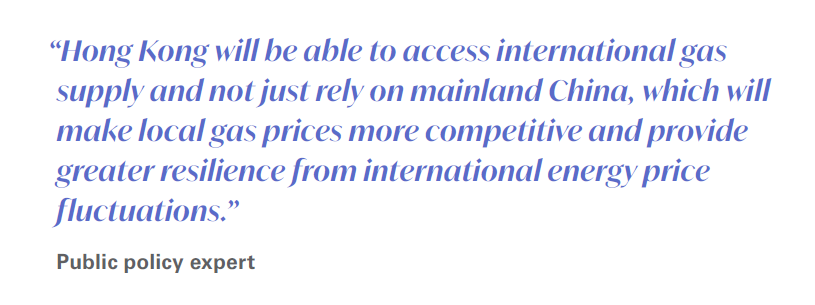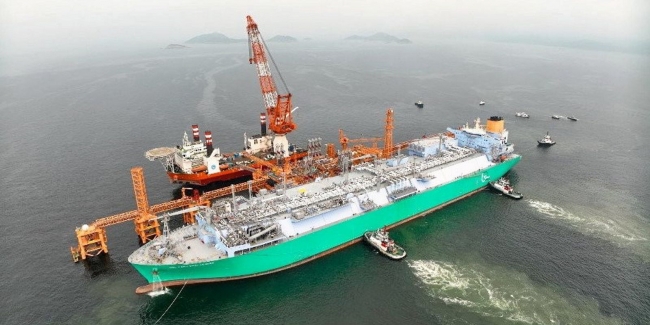Hong Kong joins the LNG importer ranks [Gas in Transition]
Hong Kong’s formal launch of its maiden LNG terminal this summer represents a long-awaited embrace of the cleaner-burning fuel by the Asian financial hub, which is leaning on greater gas burn to underpin a drive away from coal-fired power generation.
The offshore LNG terminal – the largest of its kind in the world – received its first LNG shipment under a long-term supply agreement between Shell and local power companies CLP Power Hong Kong and Hong Kong Electric, the two utilities announced on July 13. CLP Power and Hong Kong Electric own respective stakes of 49% and 30% in the project. The remaining 21% interest is owned by China Southern Power Grid, one of two state-owned grid monopolies in mainland China.
Regasified LNG is now being sent to CLP Power’s Black Point Power Station and HK Electric’s Lamma Power Station, raising the low-carbon generation capability and fuel supply security of the power companies in support of Hong Kong’s energy transition.
“Hong Kong will be able to access international gas supply and not just rely on mainland China, which will make local gas prices more competitive and provide greater resilience from international energy price fluctuations,” a public policy expert in Hong Kong told NGW. “It also can help Hong Kong to figure out if it can upgrade the terminal to a hydrogen receiving terminal in the future.”
LNG to drive coal-to-gas switching
The floating storage and regasification unit-based (FSRU) terminal was built under the development structure of Hong Kong’s Climate Action Plan 2050 unveiled in October 2021. The plan pledged to halve carbon emissions before 2035 compared with 2005 levels, and to achieve carbon neutrality before 2050. Achieving this will require deep cuts in fossil fuels in Hong Kong’s power sector – the source of two-thirds of the city’s greenhouse gas emissions.
Hong Kong’s newfound status as an LNG importer means its decarbonisation targets remain “on track”, a Hong Kong-based energy analyst told NGW. “More gas will be available, more choices and more flexibility,” said the analyst, who at the same time cautioned: “Let’s not get ahead of ourselves. This is a step on a lengthy journey, of course.”
Hong Kong’s gas consumption in 2022 declined for the second year in a row, falling by 6.4% to 4.5bn m³ in 2022, although this came after exceptional growth of 58.2% in 2020, according to the Energy Institute’s Statistical Review of World Energy 2023. Power generation accounted for the lion’s share as the residential, commercial and industrial sectors only consumed a combined 800mn m³ in 2022, according to Hong Kong and China Gas Company, the city’s gas distribution monopoly.
Gas dominates Hong Kong’s power generation fuel mix, making up 48% of the total in 2020, according to official statistics. Non-fossil fuel sources including imports from the Daya Bay nuclear power plant in neighbouring Guangdong province and renewable energy projects represented a combined 28%, while coal accounted for the remaining 24%.
The Climate Action Plan 2050 calls for Hong Kong to stop burning coal for daily electricity generation by 2035, replacing the dirtiest fossil fuel with low- to zero-carbon energy sources.
This ambitious target means that while it is early days for Hong Kong’s new terminal, it will likely be kept busy by rising demand for gas-fired power generation. In mid-2019 CLP and Hong Kong Electric signed a contract with Shell to supply the project – the volume and term length were not disclosed but reports at the time indicated 1.2mn metric tons/yr would be supplied for 10 years starting after 2020.
Offshore behemoth
Located 25 km offshore southwestern Hong Kong, the terminal comprises the 263,000 m³ Bauhinia Spirit – the world’s biggest FSRU, jointly owned and operated by Mitsui O.S.K. Lines and Vopak – and the first offshore all-steel jetty to berth two LNG carriers simultaneously, according to contractor Offshore Oil Engineering, a Shanghai-listed subsidiary of Chinese state-owned CNOOC.
 The 345-m long Bauhinia Spirit vessel has a nominal regasification capacity of 600mn f³/d (16.8mn m³/d) with a maximum capacity of 800mn f³/d, while the wharf is designed for a 50-year service life – twice as long as conventional offshore LNG receiving stations. Also part of the project is an onshore LNG terminal and two undersea pipelines spanning a length of 63 km.
The 345-m long Bauhinia Spirit vessel has a nominal regasification capacity of 600mn f³/d (16.8mn m³/d) with a maximum capacity of 800mn f³/d, while the wharf is designed for a 50-year service life – twice as long as conventional offshore LNG receiving stations. Also part of the project is an onshore LNG terminal and two undersea pipelines spanning a length of 63 km.
The Maran Gas Coronis carrier finished unloading a commissioning cargo from PetroChina/CNPC for the terminal on May 14, marking the start of trial operation and Hong Kong’s maiden receipt of an LNG shipment. CLP purchased an LNG cargo for May delivery back in March, with the price linked to the Japan-Korea Marker.
The Hong Kong government had hoped to start importing LNG three years ago, but its plans were scuppered by the start of COVID-19 in early 2020. The project’s start-up was first delayed until the end of 2020 — a year later than originally planned — following a setback to the start of construction, which began in 2020. A months-long Omicron outbreak in early 2022, coupled with last year’s global energy shortages, then delayed first gas from March 2022 to this summer.
A long time coming
The terminal has been two decades in the making. Hong Kong’s gas needs were initially met by CNOOC’s Yacheng 13-1 gas field located in the Yinggehai Basin offshore China’s southern island province of Hainan. Yacheng 13-1 was one of China’s four largest offshore gas fields when it started commercial production in 1996 but output peaked at 3.0bn m³/yr early on and had dwindled to a fraction of this by late 2019.
Amid fears that Yacheng 13-1 would start to become depleted as early as 2012, CLP concluded in 2003 that an LNG terminal was “the only viable means of providing an adequate, secure and reliable supply of gas within the necessary time frame to meet Hong Kong’s requirements”.
In 2008 the Hong Kong government signed a memorandum of understanding (MoU) with China’s National Energy Administration (NEA) on enhancing support on gas supply to Hong Kong in the following 20 years. Under the MoU, the NEA said it would support a renewal of CNOOC’s supply agreement with Hong Kong for an additional 20 years.
Under the MoU, the feasibility of supplying piped gas to Hong Kong via the second West-East pipeline (WEP2) – owned by PetroChina at the time – would be studied, while China’s central government would work with Hong Kong to build an LNG terminal to supply the city. In the end, the LNG terminal sought by CLP was shelved in favour of WEP2, which started transmitting gas to the city in mid-2013.
WEP2 mainly supplies expensive gas to Hong Kong that was originally imported from Central Asia by PetroChina, and LNG imports would have worked out to be cheaper over the same period, an industry source told NGW. “Still, better late than never,” the source added.
Compensating for limited renewable potential
More gas burn will be critical going forward if Hong Kong is to meet its climate targets while keeping the lights on. The government’s Climate Action Plan 2050 is targeting an increase in the share of renewables in Hong Kong’s power mix to 7.5-10% by 2035 or earlier, rising to 15% gradually thereafter, while 60-70% of zero-carbon electricity supply should be sourced via closer cooperation with neighbouring areas.
But upping the contribution of solar and wind energy will be difficult as deployment is constrained by Hong Kong’s geography and resources. Renewables presently meet less than 1% of local power demand, and analysis from the World Resources Institute (WRI) has found renewables could supply no more than 4% of Hong Kong’s electricity demand by 2030 and 10% by 2050.
Coal-to-gas switching in the power sector has already helped Hong Kong make in-roads in decarbonisation. Emissions data for 2020 released last year showed that emissions from electricity generation and other energy industries stood at 20.4mn mt of CO2 equivalent in 2020, down by 22% from 26.3mn mt in 2019.
A long-term bet on gas?
Hong Kong’s embrace of LNG would appear to suggest the city has settled on a gas-based energy mix as its preferred route to a net-zero power system, but insiders said this is not necessarily the case.
“The answer is yes and no. It mainly means that Hong Kong can reduce generation from coal while maintaining secure supply and setting up further future options and decisions on decarbonisation pathways,” said the energy analyst.
“Hong Kong will eventually need to find other energy sources or resources, but LNG and higher-efficiency generation units are a reasonable start given the lack of alternatives for now, the opportunity to reduce coal-fired generation further, and the vital importance of energy security as well.”
Continuing to burn gas around after this decade could require Hong Kong to deploy carbon capture, utilisation and storage (CCUS). But gas likely has no future towards the middle of this century, when Hong Kong is aiming to achieve carbon neutrality. A power mix 65%-based on unabated gas in 2050 would perform the worst in terms of economic competitiveness, carbon emissions and air pollution, associated health concerns and supply diversity, according to a 2021 report from the WRI.





